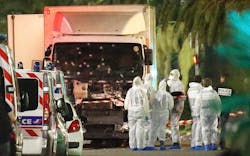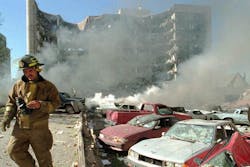The horrific terror attack committed in Nice, France, highlights a disturbing use for the everyday commercial truck, one most of us in this industry don’t like thinking about: as a weapon for mayhem and murder.
Some 84 people are now known to be killed, along with scores of others maimed and wounded, after a terrorist behind the wheel of a straight truck plowed into a crowd of Bastille Day revelers at high speed, then exited the cab and began shooting.
French police killed the terrorist in a running gun battle (once again, police step in to protect and save lives) so figuring out his dastardly allegiances will take time.
But using a truck as a weapon … it’s been done before with extremely deadly effect all over the world: The 1983 Marine barracks bombing in Beirut, Lebanon, (for which the Iranians must now pay damages); the first World Trade Center attack in 1993; and the infamous Oklahoma City bombing carried out by Timothy McVeigh in 1995.
The challenge facing transportation experts now is to figure out what kinds of trucks pose the biggest “weaponized” threat and how to counteract it.
The Mineta Transportation Institute (MTI) for example tracks terrorist attacks as they related to transportation and finds that bombings are the most common tactic used in Western Europe and North America – and the most lethal. Which the Nice terrorist used his truck as a weapon instead of a bomb, running over people instead of packing it with explosives, the goal is the same: create a “mass causality event” that generates headlines; a goal that is unfortunately becoming easier for lone individuals to do.
The MTI database noted that while bombings comprise 67% of all terrorist attacks in its records, they caused 95% of the fatalities; those in enclosed environments like subway trains and enclosed stations comprised 13% of the bombings, but caused 71% of the fatalities.
Over time, high lethality attacks have increased in Western Countries, especially the March 11, 2004, Madrid train bombings that killed 191 people and the July 7, 2005, London subway bombings that killed 52.
And worldwide the trend is even more spectacular: attacks with 25 or more fatalities on buses, trains and passenger ferries increased from just four between 1975 and 1985 to 39 between 2005 and 2015.
Why? Because public surface transportation—trains, metros, subways, and buses—offer terrorists easy access and crowds of people, especially in terms of getting high body counts, Bruce Butterworth, a Mineta research associate and former director of aviation security operations at the Federal Aviation Administration (FAA), explained to me in an interview last month.
And just like what occurred in Nice, suicide attacks comprise a small but increasing proportion of the total number of attacks and are usually a more lethal tactic, MTI found.
In Europe, Jihadist attacks are becoming more lethal than non-jihadist attacks and the Jihadist worldview – that their violence is sanctioned by God – loosens any self-imposed constraints and drives them to seek high body counts. Indeed, MTI found that 11 Jihadist attacks – a small fraction of the total terrorist attacks in the firm’s database – caused 50% of the fatalities, mainly due to the aforementioned Madrid and London attacks, as well as the attack on March 22 this year upon the Brussels Metro station in Belgium.
While trucking networks themselves – including those in the U.S. – are not considered ideal targets for terrorist strikes in MTI’s eyes, simply because few people are involved, using trucks as weapons is a big worry, especially where tanker fleets are concerned.
“While we primarily focus on the surface transportation of the public by rail and by bus, it is probably fair to say that for attackers seeking high body counts with a minimum of complications – such as the jihadists we are most concerned about – your average commercial truck does not present a target more valuable than a mass transit system of a large city that carries large number of people and upon which people rely, or buses where people also rely on them,” Butterworth told me.“A key exception to what we say about commercial trucking would be gasoline and, to a lesser degree, propane tankers which carry commodities that could not attacked themselves, but used to attack infrastructure and more important targets such as buildings or even open air events where large numbers of people could be consumed by fire and or explosive force,” he stressed.
“It seems these commodities are transported by necessity frequently and with less controls than other dangerous cargos,” Butterworth added.
Yet one thing often overlooked in examining past terrorist attacks revolves around the ones foiled by “alert individuals” in MTI’s parlance.
The group noted that in Western Europe alone such “alert individuals” – officials, employees or passengers – detected and stopped 11% of bomb attacks against buses and trains since 1970 and 14% of bomb attacks against infrastructure targets such as railroad tracks.
The comparable figures in the U.S. and Canada are 18% and 20%, MTI said.
“Security measures can and do often work, but the challenge remains,” stressed Brian Michael Jenkins, director of the MTI’s Safety and Security Center, in one of the group’s most recent reports.
“Public surface transportation is an attractive terrorist target. Attacks can result in significant fatalities [and] continued efforts are needed to analyze patterns and decide how to most cost effectively reduce that risk,” he stressed. “But authorities have not been asleep at the switch, a conclusion that detracts from, rather than adds to, the importance of that conclusion.”
Quick-on-their-feet police in Nice managed to kill the truck terrorist before he could continue his attack – saving who knows how many lives in the process.
Let us pray police in our nation don’t face a similar situation anytime soon … or hopefully ever.


